Organisational Behaviour: Exploring Perception's Role in Organisations
VerifiedAdded on 2023/06/14
|7
|2180
|308
Essay
AI Summary
This essay explores organisational behaviour, focusing on the critical role of perception in shaping individual attitudes and organisational performance. It examines how perception, influenced by factors like personal experiences and biases, affects workplace dynamics. The essay discusses key concepts such as stereotyping and selective perception, highlighting their impact on decision-making and team work. It further analyses how accurate and faulty perceptions can lead to different organisational outcomes, emphasizing the importance of effective leadership in managing perceptions. Additionally, the essay addresses organisational constraints that affect individual perception and decision-making, stressing the need for managers to understand and address employee perceptions for overall organisational success. Access more solved assignments and study resources on Desklib.
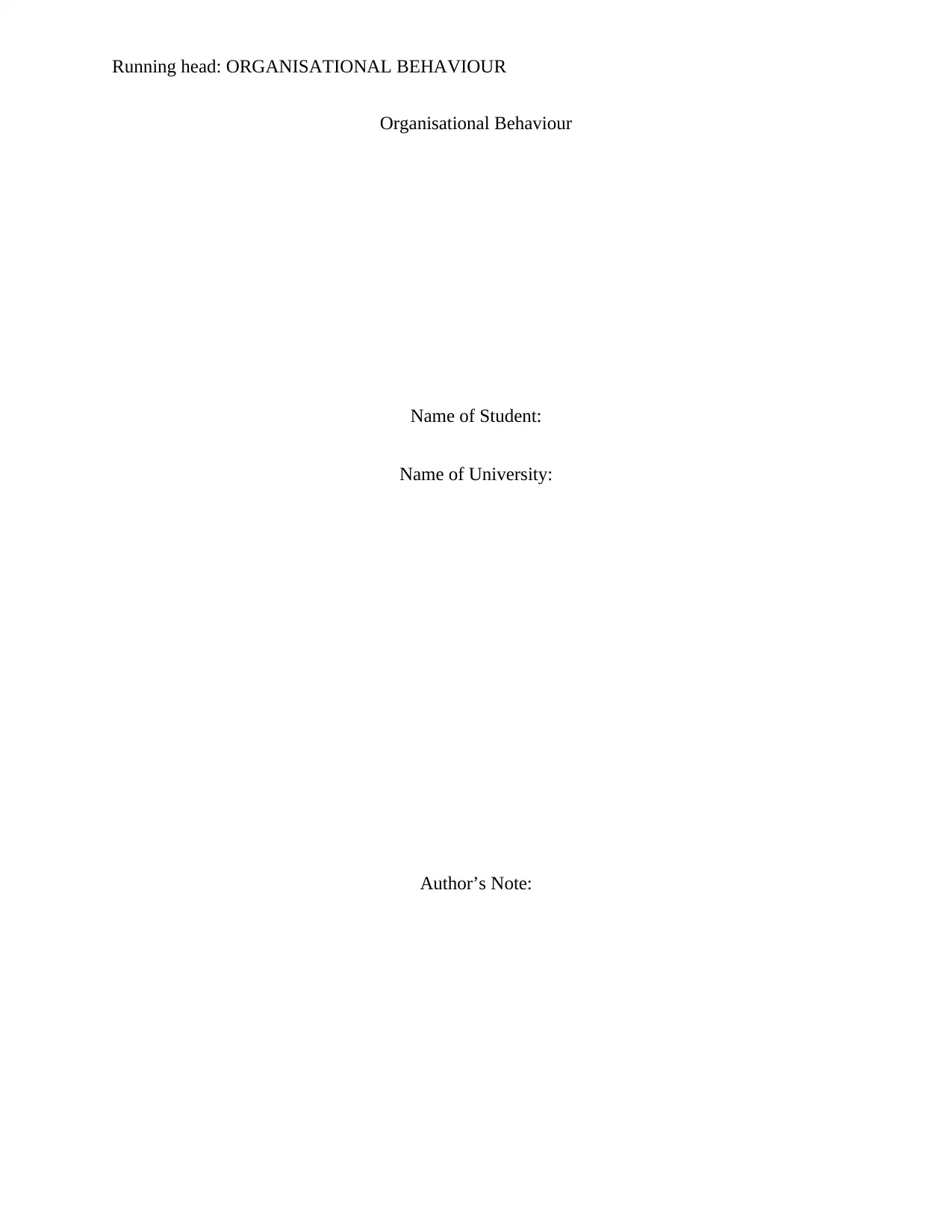
Running head: ORGANISATIONAL BEHAVIOUR
Organisational Behaviour
Name of Student:
Name of University:
Author’s Note:
Organisational Behaviour
Name of Student:
Name of University:
Author’s Note:
Paraphrase This Document
Need a fresh take? Get an instant paraphrase of this document with our AI Paraphraser
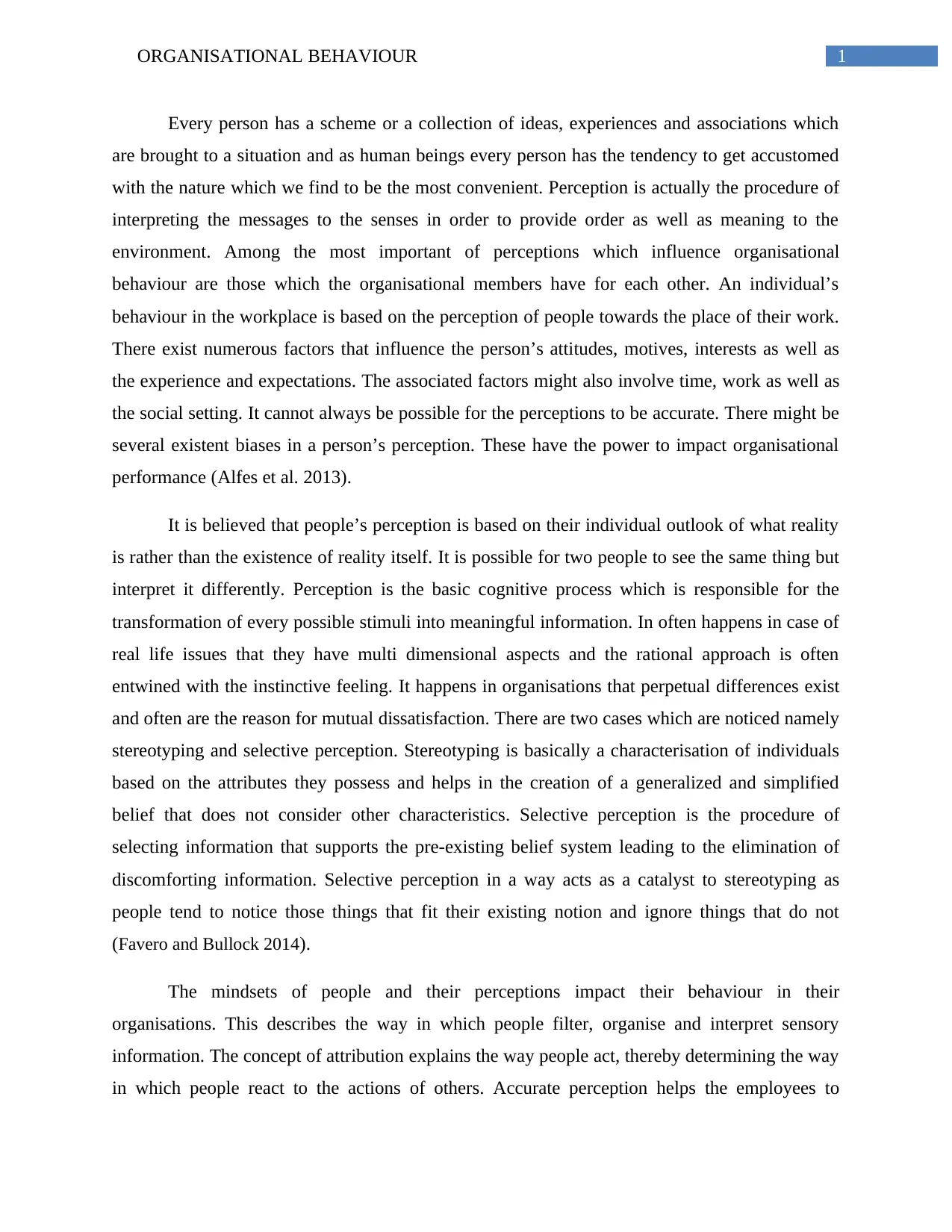
1ORGANISATIONAL BEHAVIOUR
Every person has a scheme or a collection of ideas, experiences and associations which
are brought to a situation and as human beings every person has the tendency to get accustomed
with the nature which we find to be the most convenient. Perception is actually the procedure of
interpreting the messages to the senses in order to provide order as well as meaning to the
environment. Among the most important of perceptions which influence organisational
behaviour are those which the organisational members have for each other. An individual’s
behaviour in the workplace is based on the perception of people towards the place of their work.
There exist numerous factors that influence the person’s attitudes, motives, interests as well as
the experience and expectations. The associated factors might also involve time, work as well as
the social setting. It cannot always be possible for the perceptions to be accurate. There might be
several existent biases in a person’s perception. These have the power to impact organisational
performance (Alfes et al. 2013).
It is believed that people’s perception is based on their individual outlook of what reality
is rather than the existence of reality itself. It is possible for two people to see the same thing but
interpret it differently. Perception is the basic cognitive process which is responsible for the
transformation of every possible stimuli into meaningful information. In often happens in case of
real life issues that they have multi dimensional aspects and the rational approach is often
entwined with the instinctive feeling. It happens in organisations that perpetual differences exist
and often are the reason for mutual dissatisfaction. There are two cases which are noticed namely
stereotyping and selective perception. Stereotyping is basically a characterisation of individuals
based on the attributes they possess and helps in the creation of a generalized and simplified
belief that does not consider other characteristics. Selective perception is the procedure of
selecting information that supports the pre-existing belief system leading to the elimination of
discomforting information. Selective perception in a way acts as a catalyst to stereotyping as
people tend to notice those things that fit their existing notion and ignore things that do not
(Favero and Bullock 2014).
The mindsets of people and their perceptions impact their behaviour in their
organisations. This describes the way in which people filter, organise and interpret sensory
information. The concept of attribution explains the way people act, thereby determining the way
in which people react to the actions of others. Accurate perception helps the employees to
Every person has a scheme or a collection of ideas, experiences and associations which
are brought to a situation and as human beings every person has the tendency to get accustomed
with the nature which we find to be the most convenient. Perception is actually the procedure of
interpreting the messages to the senses in order to provide order as well as meaning to the
environment. Among the most important of perceptions which influence organisational
behaviour are those which the organisational members have for each other. An individual’s
behaviour in the workplace is based on the perception of people towards the place of their work.
There exist numerous factors that influence the person’s attitudes, motives, interests as well as
the experience and expectations. The associated factors might also involve time, work as well as
the social setting. It cannot always be possible for the perceptions to be accurate. There might be
several existent biases in a person’s perception. These have the power to impact organisational
performance (Alfes et al. 2013).
It is believed that people’s perception is based on their individual outlook of what reality
is rather than the existence of reality itself. It is possible for two people to see the same thing but
interpret it differently. Perception is the basic cognitive process which is responsible for the
transformation of every possible stimuli into meaningful information. In often happens in case of
real life issues that they have multi dimensional aspects and the rational approach is often
entwined with the instinctive feeling. It happens in organisations that perpetual differences exist
and often are the reason for mutual dissatisfaction. There are two cases which are noticed namely
stereotyping and selective perception. Stereotyping is basically a characterisation of individuals
based on the attributes they possess and helps in the creation of a generalized and simplified
belief that does not consider other characteristics. Selective perception is the procedure of
selecting information that supports the pre-existing belief system leading to the elimination of
discomforting information. Selective perception in a way acts as a catalyst to stereotyping as
people tend to notice those things that fit their existing notion and ignore things that do not
(Favero and Bullock 2014).
The mindsets of people and their perceptions impact their behaviour in their
organisations. This describes the way in which people filter, organise and interpret sensory
information. The concept of attribution explains the way people act, thereby determining the way
in which people react to the actions of others. Accurate perception helps the employees to
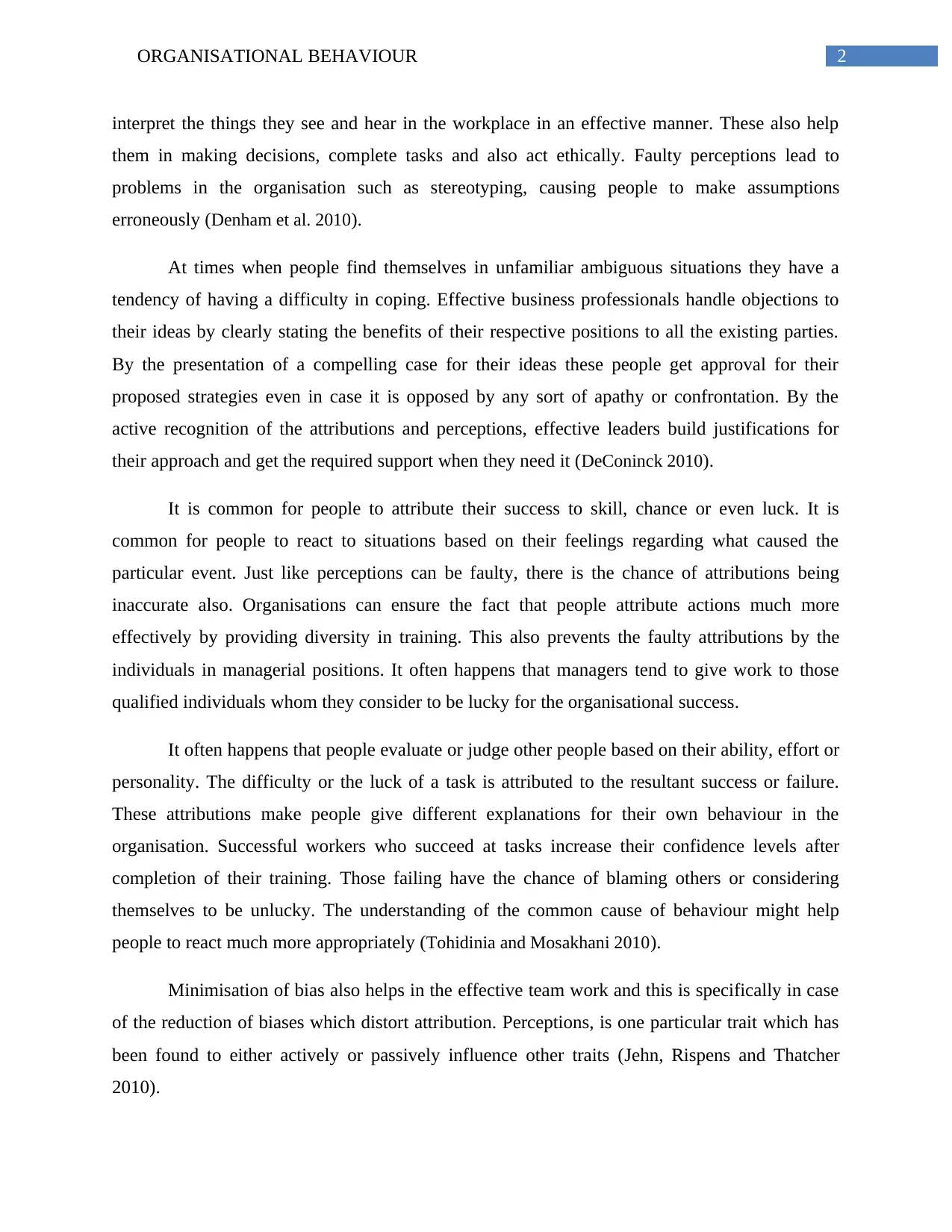
2ORGANISATIONAL BEHAVIOUR
interpret the things they see and hear in the workplace in an effective manner. These also help
them in making decisions, complete tasks and also act ethically. Faulty perceptions lead to
problems in the organisation such as stereotyping, causing people to make assumptions
erroneously (Denham et al. 2010).
At times when people find themselves in unfamiliar ambiguous situations they have a
tendency of having a difficulty in coping. Effective business professionals handle objections to
their ideas by clearly stating the benefits of their respective positions to all the existing parties.
By the presentation of a compelling case for their ideas these people get approval for their
proposed strategies even in case it is opposed by any sort of apathy or confrontation. By the
active recognition of the attributions and perceptions, effective leaders build justifications for
their approach and get the required support when they need it (DeConinck 2010).
It is common for people to attribute their success to skill, chance or even luck. It is
common for people to react to situations based on their feelings regarding what caused the
particular event. Just like perceptions can be faulty, there is the chance of attributions being
inaccurate also. Organisations can ensure the fact that people attribute actions much more
effectively by providing diversity in training. This also prevents the faulty attributions by the
individuals in managerial positions. It often happens that managers tend to give work to those
qualified individuals whom they consider to be lucky for the organisational success.
It often happens that people evaluate or judge other people based on their ability, effort or
personality. The difficulty or the luck of a task is attributed to the resultant success or failure.
These attributions make people give different explanations for their own behaviour in the
organisation. Successful workers who succeed at tasks increase their confidence levels after
completion of their training. Those failing have the chance of blaming others or considering
themselves to be unlucky. The understanding of the common cause of behaviour might help
people to react much more appropriately (Tohidinia and Mosakhani 2010).
Minimisation of bias also helps in the effective team work and this is specifically in case
of the reduction of biases which distort attribution. Perceptions, is one particular trait which has
been found to either actively or passively influence other traits (Jehn, Rispens and Thatcher
2010).
interpret the things they see and hear in the workplace in an effective manner. These also help
them in making decisions, complete tasks and also act ethically. Faulty perceptions lead to
problems in the organisation such as stereotyping, causing people to make assumptions
erroneously (Denham et al. 2010).
At times when people find themselves in unfamiliar ambiguous situations they have a
tendency of having a difficulty in coping. Effective business professionals handle objections to
their ideas by clearly stating the benefits of their respective positions to all the existing parties.
By the presentation of a compelling case for their ideas these people get approval for their
proposed strategies even in case it is opposed by any sort of apathy or confrontation. By the
active recognition of the attributions and perceptions, effective leaders build justifications for
their approach and get the required support when they need it (DeConinck 2010).
It is common for people to attribute their success to skill, chance or even luck. It is
common for people to react to situations based on their feelings regarding what caused the
particular event. Just like perceptions can be faulty, there is the chance of attributions being
inaccurate also. Organisations can ensure the fact that people attribute actions much more
effectively by providing diversity in training. This also prevents the faulty attributions by the
individuals in managerial positions. It often happens that managers tend to give work to those
qualified individuals whom they consider to be lucky for the organisational success.
It often happens that people evaluate or judge other people based on their ability, effort or
personality. The difficulty or the luck of a task is attributed to the resultant success or failure.
These attributions make people give different explanations for their own behaviour in the
organisation. Successful workers who succeed at tasks increase their confidence levels after
completion of their training. Those failing have the chance of blaming others or considering
themselves to be unlucky. The understanding of the common cause of behaviour might help
people to react much more appropriately (Tohidinia and Mosakhani 2010).
Minimisation of bias also helps in the effective team work and this is specifically in case
of the reduction of biases which distort attribution. Perceptions, is one particular trait which has
been found to either actively or passively influence other traits (Jehn, Rispens and Thatcher
2010).
⊘ This is a preview!⊘
Do you want full access?
Subscribe today to unlock all pages.

Trusted by 1+ million students worldwide
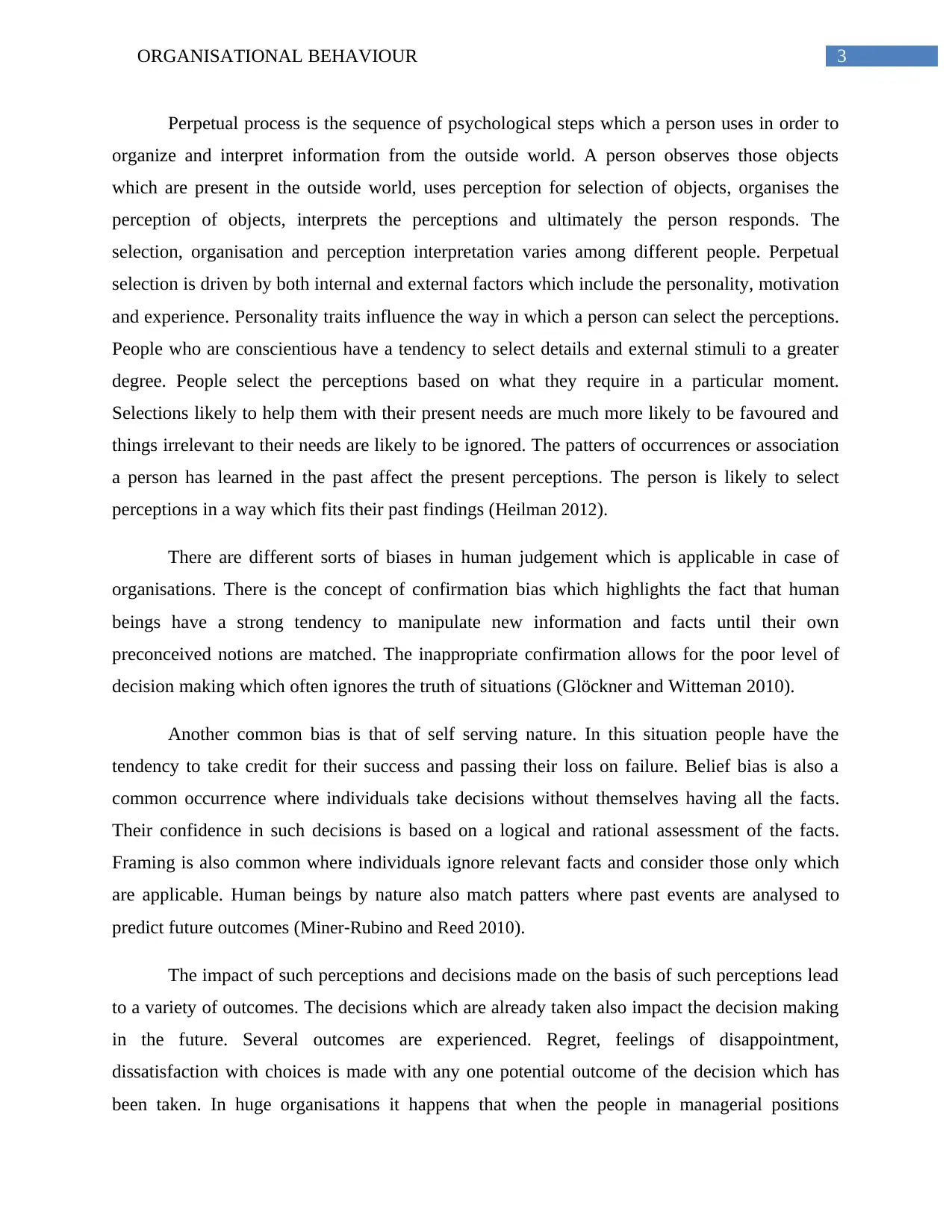
3ORGANISATIONAL BEHAVIOUR
Perpetual process is the sequence of psychological steps which a person uses in order to
organize and interpret information from the outside world. A person observes those objects
which are present in the outside world, uses perception for selection of objects, organises the
perception of objects, interprets the perceptions and ultimately the person responds. The
selection, organisation and perception interpretation varies among different people. Perpetual
selection is driven by both internal and external factors which include the personality, motivation
and experience. Personality traits influence the way in which a person can select the perceptions.
People who are conscientious have a tendency to select details and external stimuli to a greater
degree. People select the perceptions based on what they require in a particular moment.
Selections likely to help them with their present needs are much more likely to be favoured and
things irrelevant to their needs are likely to be ignored. The patters of occurrences or association
a person has learned in the past affect the present perceptions. The person is likely to select
perceptions in a way which fits their past findings (Heilman 2012).
There are different sorts of biases in human judgement which is applicable in case of
organisations. There is the concept of confirmation bias which highlights the fact that human
beings have a strong tendency to manipulate new information and facts until their own
preconceived notions are matched. The inappropriate confirmation allows for the poor level of
decision making which often ignores the truth of situations (Glöckner and Witteman 2010).
Another common bias is that of self serving nature. In this situation people have the
tendency to take credit for their success and passing their loss on failure. Belief bias is also a
common occurrence where individuals take decisions without themselves having all the facts.
Their confidence in such decisions is based on a logical and rational assessment of the facts.
Framing is also common where individuals ignore relevant facts and consider those only which
are applicable. Human beings by nature also match patters where past events are analysed to
predict future outcomes (Miner‐Rubino and Reed 2010).
The impact of such perceptions and decisions made on the basis of such perceptions lead
to a variety of outcomes. The decisions which are already taken also impact the decision making
in the future. Several outcomes are experienced. Regret, feelings of disappointment,
dissatisfaction with choices is made with any one potential outcome of the decision which has
been taken. In huge organisations it happens that when the people in managerial positions
Perpetual process is the sequence of psychological steps which a person uses in order to
organize and interpret information from the outside world. A person observes those objects
which are present in the outside world, uses perception for selection of objects, organises the
perception of objects, interprets the perceptions and ultimately the person responds. The
selection, organisation and perception interpretation varies among different people. Perpetual
selection is driven by both internal and external factors which include the personality, motivation
and experience. Personality traits influence the way in which a person can select the perceptions.
People who are conscientious have a tendency to select details and external stimuli to a greater
degree. People select the perceptions based on what they require in a particular moment.
Selections likely to help them with their present needs are much more likely to be favoured and
things irrelevant to their needs are likely to be ignored. The patters of occurrences or association
a person has learned in the past affect the present perceptions. The person is likely to select
perceptions in a way which fits their past findings (Heilman 2012).
There are different sorts of biases in human judgement which is applicable in case of
organisations. There is the concept of confirmation bias which highlights the fact that human
beings have a strong tendency to manipulate new information and facts until their own
preconceived notions are matched. The inappropriate confirmation allows for the poor level of
decision making which often ignores the truth of situations (Glöckner and Witteman 2010).
Another common bias is that of self serving nature. In this situation people have the
tendency to take credit for their success and passing their loss on failure. Belief bias is also a
common occurrence where individuals take decisions without themselves having all the facts.
Their confidence in such decisions is based on a logical and rational assessment of the facts.
Framing is also common where individuals ignore relevant facts and consider those only which
are applicable. Human beings by nature also match patters where past events are analysed to
predict future outcomes (Miner‐Rubino and Reed 2010).
The impact of such perceptions and decisions made on the basis of such perceptions lead
to a variety of outcomes. The decisions which are already taken also impact the decision making
in the future. Several outcomes are experienced. Regret, feelings of disappointment,
dissatisfaction with choices is made with any one potential outcome of the decision which has
been taken. In huge organisations it happens that when the people in managerial positions
Paraphrase This Document
Need a fresh take? Get an instant paraphrase of this document with our AI Paraphraser
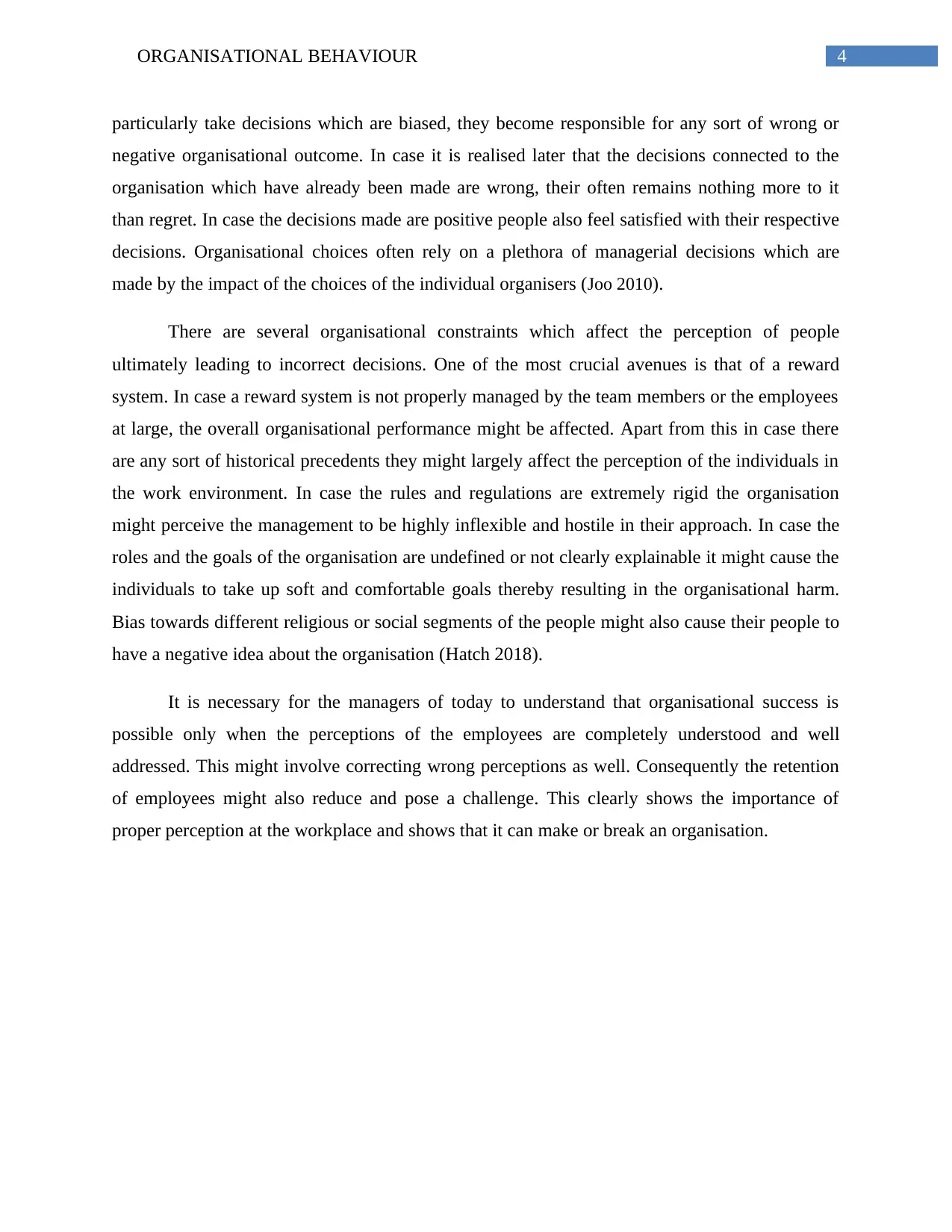
4ORGANISATIONAL BEHAVIOUR
particularly take decisions which are biased, they become responsible for any sort of wrong or
negative organisational outcome. In case it is realised later that the decisions connected to the
organisation which have already been made are wrong, their often remains nothing more to it
than regret. In case the decisions made are positive people also feel satisfied with their respective
decisions. Organisational choices often rely on a plethora of managerial decisions which are
made by the impact of the choices of the individual organisers (Joo 2010).
There are several organisational constraints which affect the perception of people
ultimately leading to incorrect decisions. One of the most crucial avenues is that of a reward
system. In case a reward system is not properly managed by the team members or the employees
at large, the overall organisational performance might be affected. Apart from this in case there
are any sort of historical precedents they might largely affect the perception of the individuals in
the work environment. In case the rules and regulations are extremely rigid the organisation
might perceive the management to be highly inflexible and hostile in their approach. In case the
roles and the goals of the organisation are undefined or not clearly explainable it might cause the
individuals to take up soft and comfortable goals thereby resulting in the organisational harm.
Bias towards different religious or social segments of the people might also cause their people to
have a negative idea about the organisation (Hatch 2018).
It is necessary for the managers of today to understand that organisational success is
possible only when the perceptions of the employees are completely understood and well
addressed. This might involve correcting wrong perceptions as well. Consequently the retention
of employees might also reduce and pose a challenge. This clearly shows the importance of
proper perception at the workplace and shows that it can make or break an organisation.
particularly take decisions which are biased, they become responsible for any sort of wrong or
negative organisational outcome. In case it is realised later that the decisions connected to the
organisation which have already been made are wrong, their often remains nothing more to it
than regret. In case the decisions made are positive people also feel satisfied with their respective
decisions. Organisational choices often rely on a plethora of managerial decisions which are
made by the impact of the choices of the individual organisers (Joo 2010).
There are several organisational constraints which affect the perception of people
ultimately leading to incorrect decisions. One of the most crucial avenues is that of a reward
system. In case a reward system is not properly managed by the team members or the employees
at large, the overall organisational performance might be affected. Apart from this in case there
are any sort of historical precedents they might largely affect the perception of the individuals in
the work environment. In case the rules and regulations are extremely rigid the organisation
might perceive the management to be highly inflexible and hostile in their approach. In case the
roles and the goals of the organisation are undefined or not clearly explainable it might cause the
individuals to take up soft and comfortable goals thereby resulting in the organisational harm.
Bias towards different religious or social segments of the people might also cause their people to
have a negative idea about the organisation (Hatch 2018).
It is necessary for the managers of today to understand that organisational success is
possible only when the perceptions of the employees are completely understood and well
addressed. This might involve correcting wrong perceptions as well. Consequently the retention
of employees might also reduce and pose a challenge. This clearly shows the importance of
proper perception at the workplace and shows that it can make or break an organisation.
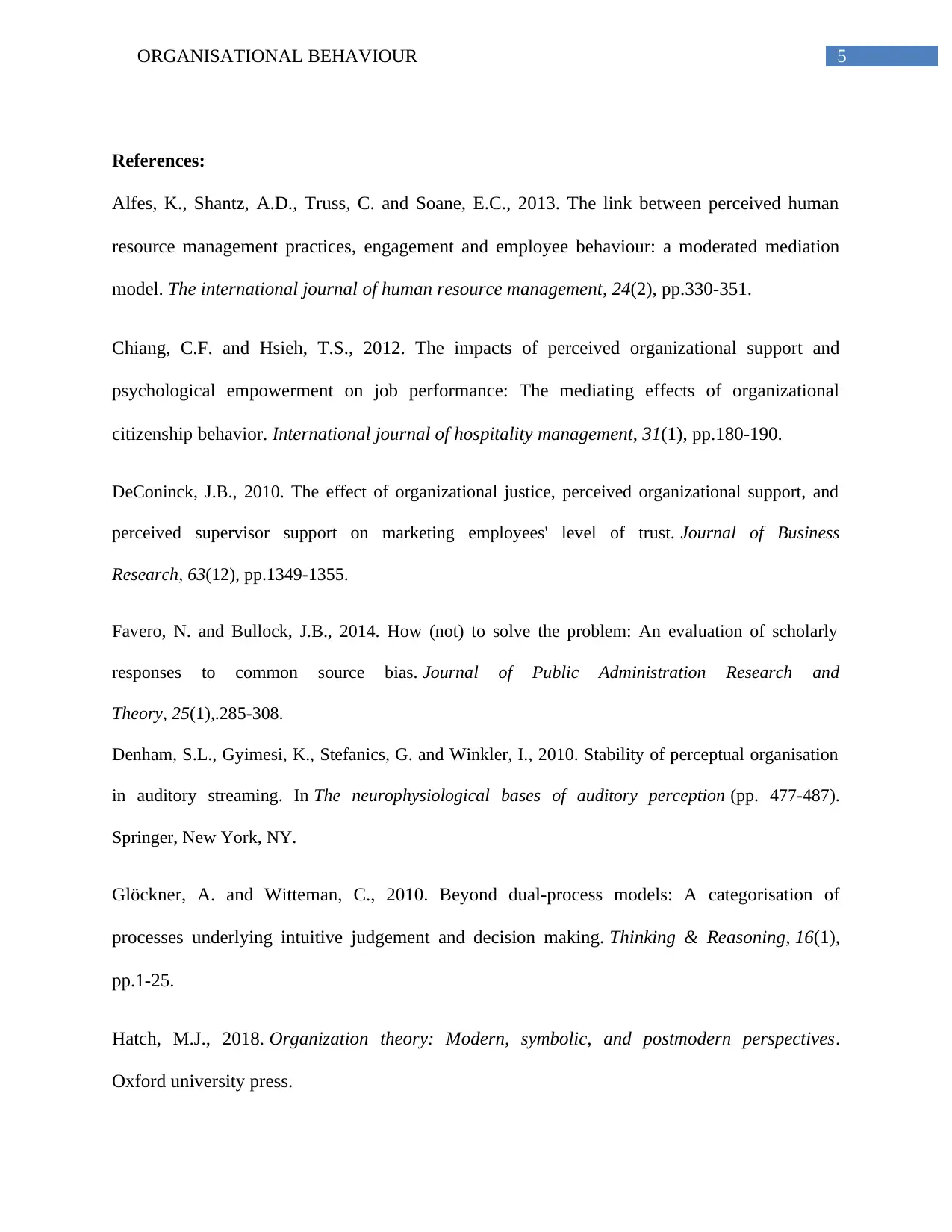
5ORGANISATIONAL BEHAVIOUR
References:
Alfes, K., Shantz, A.D., Truss, C. and Soane, E.C., 2013. The link between perceived human
resource management practices, engagement and employee behaviour: a moderated mediation
model. The international journal of human resource management, 24(2), pp.330-351.
Chiang, C.F. and Hsieh, T.S., 2012. The impacts of perceived organizational support and
psychological empowerment on job performance: The mediating effects of organizational
citizenship behavior. International journal of hospitality management, 31(1), pp.180-190.
DeConinck, J.B., 2010. The effect of organizational justice, perceived organizational support, and
perceived supervisor support on marketing employees' level of trust. Journal of Business
Research, 63(12), pp.1349-1355.
Favero, N. and Bullock, J.B., 2014. How (not) to solve the problem: An evaluation of scholarly
responses to common source bias. Journal of Public Administration Research and
Theory, 25(1),.285-308.
Denham, S.L., Gyimesi, K., Stefanics, G. and Winkler, I., 2010. Stability of perceptual organisation
in auditory streaming. In The neurophysiological bases of auditory perception (pp. 477-487).
Springer, New York, NY.
Glöckner, A. and Witteman, C., 2010. Beyond dual-process models: A categorisation of
processes underlying intuitive judgement and decision making. Thinking & Reasoning, 16(1),
pp.1-25.
Hatch, M.J., 2018. Organization theory: Modern, symbolic, and postmodern perspectives.
Oxford university press.
References:
Alfes, K., Shantz, A.D., Truss, C. and Soane, E.C., 2013. The link between perceived human
resource management practices, engagement and employee behaviour: a moderated mediation
model. The international journal of human resource management, 24(2), pp.330-351.
Chiang, C.F. and Hsieh, T.S., 2012. The impacts of perceived organizational support and
psychological empowerment on job performance: The mediating effects of organizational
citizenship behavior. International journal of hospitality management, 31(1), pp.180-190.
DeConinck, J.B., 2010. The effect of organizational justice, perceived organizational support, and
perceived supervisor support on marketing employees' level of trust. Journal of Business
Research, 63(12), pp.1349-1355.
Favero, N. and Bullock, J.B., 2014. How (not) to solve the problem: An evaluation of scholarly
responses to common source bias. Journal of Public Administration Research and
Theory, 25(1),.285-308.
Denham, S.L., Gyimesi, K., Stefanics, G. and Winkler, I., 2010. Stability of perceptual organisation
in auditory streaming. In The neurophysiological bases of auditory perception (pp. 477-487).
Springer, New York, NY.
Glöckner, A. and Witteman, C., 2010. Beyond dual-process models: A categorisation of
processes underlying intuitive judgement and decision making. Thinking & Reasoning, 16(1),
pp.1-25.
Hatch, M.J., 2018. Organization theory: Modern, symbolic, and postmodern perspectives.
Oxford university press.
⊘ This is a preview!⊘
Do you want full access?
Subscribe today to unlock all pages.

Trusted by 1+ million students worldwide
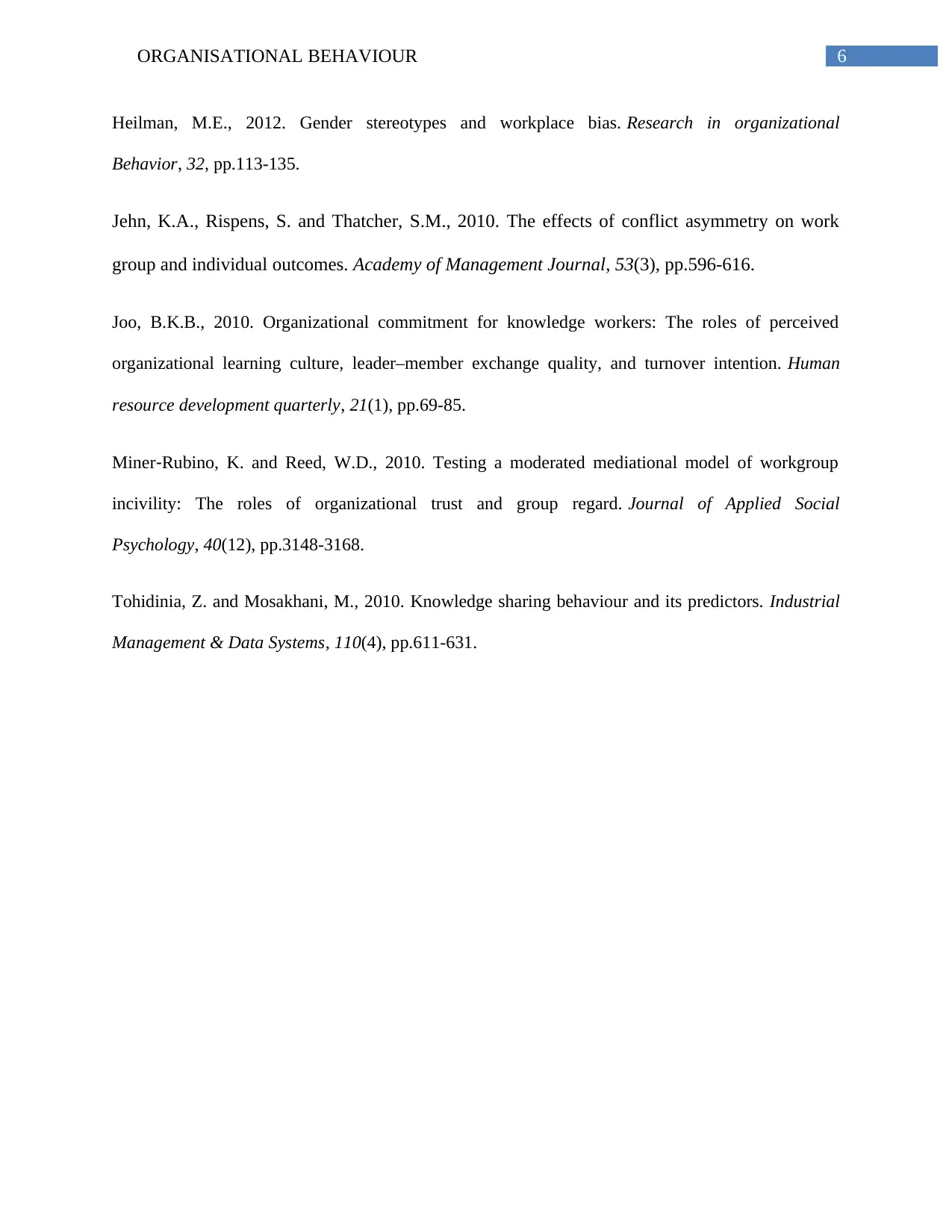
6ORGANISATIONAL BEHAVIOUR
Heilman, M.E., 2012. Gender stereotypes and workplace bias. Research in organizational
Behavior, 32, pp.113-135.
Jehn, K.A., Rispens, S. and Thatcher, S.M., 2010. The effects of conflict asymmetry on work
group and individual outcomes. Academy of Management Journal, 53(3), pp.596-616.
Joo, B.K.B., 2010. Organizational commitment for knowledge workers: The roles of perceived
organizational learning culture, leader–member exchange quality, and turnover intention. Human
resource development quarterly, 21(1), pp.69-85.
Miner‐Rubino, K. and Reed, W.D., 2010. Testing a moderated mediational model of workgroup
incivility: The roles of organizational trust and group regard. Journal of Applied Social
Psychology, 40(12), pp.3148-3168.
Tohidinia, Z. and Mosakhani, M., 2010. Knowledge sharing behaviour and its predictors. Industrial
Management & Data Systems, 110(4), pp.611-631.
Heilman, M.E., 2012. Gender stereotypes and workplace bias. Research in organizational
Behavior, 32, pp.113-135.
Jehn, K.A., Rispens, S. and Thatcher, S.M., 2010. The effects of conflict asymmetry on work
group and individual outcomes. Academy of Management Journal, 53(3), pp.596-616.
Joo, B.K.B., 2010. Organizational commitment for knowledge workers: The roles of perceived
organizational learning culture, leader–member exchange quality, and turnover intention. Human
resource development quarterly, 21(1), pp.69-85.
Miner‐Rubino, K. and Reed, W.D., 2010. Testing a moderated mediational model of workgroup
incivility: The roles of organizational trust and group regard. Journal of Applied Social
Psychology, 40(12), pp.3148-3168.
Tohidinia, Z. and Mosakhani, M., 2010. Knowledge sharing behaviour and its predictors. Industrial
Management & Data Systems, 110(4), pp.611-631.
1 out of 7
Related Documents
Your All-in-One AI-Powered Toolkit for Academic Success.
+13062052269
info@desklib.com
Available 24*7 on WhatsApp / Email
![[object Object]](/_next/static/media/star-bottom.7253800d.svg)
Unlock your academic potential
Copyright © 2020–2025 A2Z Services. All Rights Reserved. Developed and managed by ZUCOL.





